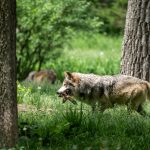Wolves have evolved into many different subspecies all able to cope perfectly with the habitat range that they have adapted to. No need to hibernate or migrate.
Do Wolves Hibernate In Winter?
Wolves do their best work in the cold winter. When other animals are really struggling to survive through lack of food, cold weather, or because they got injured during the autumn rut – the wolves can feast. Mainly feeding on hoofed mammals, the packs of wolves inhabiting northern North America, cover great distances relishing the weakness of others to feed well and raise their pups.
There are 15 different subspecies of the Gray Wolf (Canis lupus) in North America including the Red Wolf (C. l. rufus), the Eastern Wolf (C. l. lycaon), and the Arctic Wolf (C. l. arctos) to name a few – and they all have their specialist niche.
Whether they are feeding on Moose, White-tailed Deer, or Arctic Hares – they all have a habitat and temperature range that suits them best. They feed freely on any animals they set their sights on. Working as a team – a pack – makes hunting so much easier.
Wolves have no way of storing excess body fat and nutrients for a full winter of hibernation. Unlike true hibernating species, wolves must keep feeding through the whole winter to survive. They may den up temporarily in really bad weather – but cannot go for more than a few days without food – especially if they have cubs to raise. No hibernating for wolves.
Where Do Wolves Migrate To?
Although wolves can travel hundreds of miles in search of food or for new territory – they don’t technically migrate. Migration is deemed to be an annual journey from one feeding ground to another and back again – usually from summer to winter grounds. However, the great distances that wolves travel aren’t in a regular pattern, and neither is it dependent on the weather. It is just on a journey to find food – wherever that may be.
Often when the feeding is good – they will settle in the same territory and never leave. More remote wolf packs or those in extreme environments on the edges of the subspecies range may have to keep moving to follow herds of animals along their migration route to stay well fed. The stronger, more dominant packs always inhabit the best feeding ranges – the outliers always just about manage with whatever they can find.
Wolves, in general, live over a huge area in North America – however, subspecies don’t really overlap to any great extent. They can almost be seen as layers across the map, where the temperature or dominant landscape features control where they can survive. Hunting can create gaps in their known range not because they are lacking in prey or struggling to survive – but because they are targeted by humans in large numbers.
How Many Types Of Wolf Are There?
Biologically there are only three types of ‘wolf’ in the canid family tree – however, the latter most modern wolf has exploded into around 40 very different subspecies – including the domestic dog.
Ethiopian Wolf (Canis simensis) – large canid from the plateaus of Ethiopia
African Golden Wolf (Canis lupaster) – smaller jackal-like canid from Africa
Gray Wolf (Canis lupus) – true wolves of the northern hemisphere temperate zones – and domestic dogs of all sizes.
So technically – the domestic dog – including the tiny Chihuahua and rotund French Bulldog – are genetically a Gray Wolf and can interbreed with ALL subspecies of Gray Wolf to produce fertile offspring. They are both species from the Canis genus and only size and behavior (or an empty stomach) can get in their way.
This is absolutely identical to the way that lions and tigers (both Panthera spp.) or polar bears and grizzly bears (both Ursus spp.) can produce young together too.
Do Woodchucks Hibernate like Wolves?
Woodchucks and hibernation have a unique connection. While wolves do not typically hibernate, woodchucks do. During winter, woodchucks enter a deep sleep-like state called hibernation. Their body temperature drops, and metabolic activities slow down significantly, enabling them to survive harsh conditions. Nonetheless, wolves, being more active predators, continue their daily routine throughout the year, pursuing prey and maintaining their social structures.
Can Different Wolves Breed Together?
There are around 40 different subspecies of Gray Wolf around the world and they all stick to their own patch. Whether it is in the high arctic, in the mountains, the deserts, or in more urban areas – there is a gap to be filled by a wolf.
Each subspecies has behaviors and vocalizations that are specific to their own type and they will often ignore or avoid other subspecies where their ranges overlap. Just like bears, or captive big cats, only when circumstance allows it would they interbreed.
The urge to mate is sometimes stronger than the ingrained avoidance of strangers (or science offers a helping hand) and hybrids are conceived. Hybrids are more than just a novelty in the wild – and can sometimes help to strengthen and improve a wild population by bringing in new genes. They could also be the first step to creating a new species?










